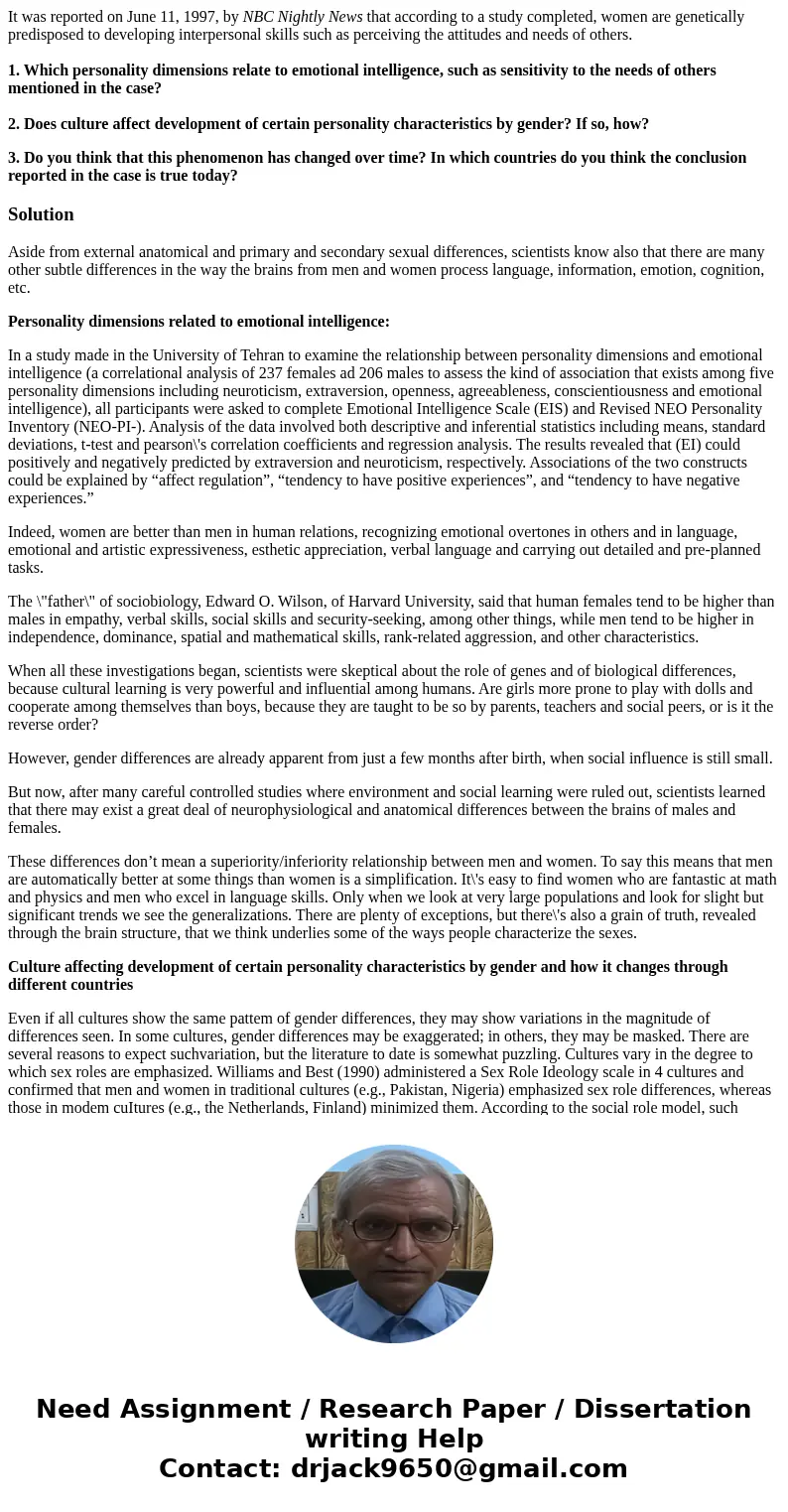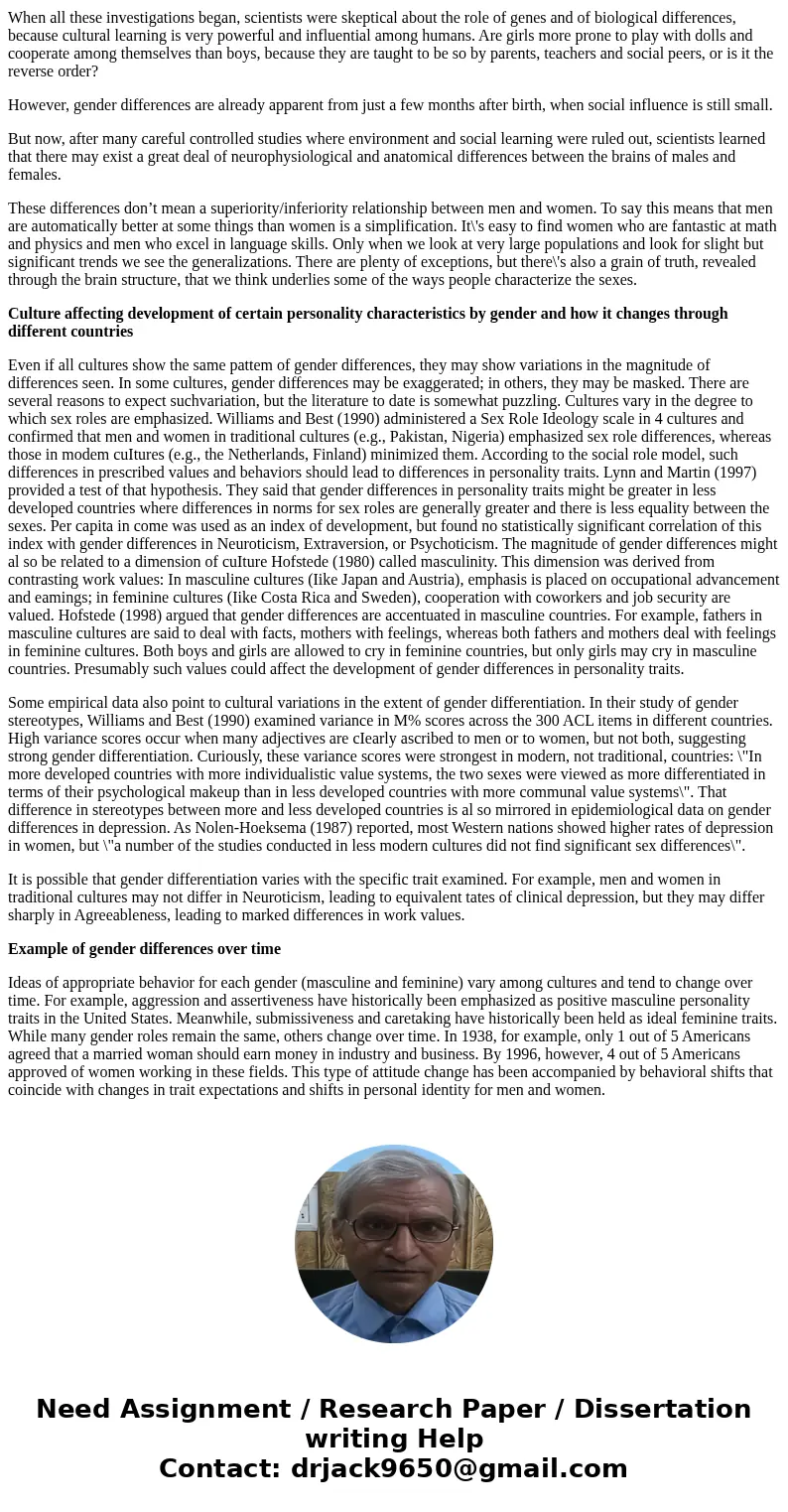It was reported on June 11 1997 by NBC Nightly News that acc
It was reported on June 11, 1997, by NBC Nightly News that according to a study completed, women are genetically predisposed to developing interpersonal skills such as perceiving the attitudes and needs of others.
1. Which personality dimensions relate to emotional intelligence, such as sensitivity to the needs of others mentioned in the case?
2. Does culture affect development of certain personality characteristics by gender? If so, how?
3. Do you think that this phenomenon has changed over time? In which countries do you think the conclusion reported in the case is true today?
Solution
Aside from external anatomical and primary and secondary sexual differences, scientists know also that there are many other subtle differences in the way the brains from men and women process language, information, emotion, cognition, etc.
Personality dimensions related to emotional intelligence:
In a study made in the University of Tehran to examine the relationship between personality dimensions and emotional intelligence (a correlational analysis of 237 females ad 206 males to assess the kind of association that exists among five personality dimensions including neuroticism, extraversion, openness, agreeableness, conscientiousness and emotional intelligence), all participants were asked to complete Emotional Intelligence Scale (EIS) and Revised NEO Personality Inventory (NEO-PI-). Analysis of the data involved both descriptive and inferential statistics including means, standard deviations, t-test and pearson\'s correlation coefficients and regression analysis. The results revealed that (EI) could positively and negatively predicted by extraversion and neuroticism, respectively. Associations of the two constructs could be explained by “affect regulation”, “tendency to have positive experiences”, and “tendency to have negative experiences.”
Indeed, women are better than men in human relations, recognizing emotional overtones in others and in language, emotional and artistic expressiveness, esthetic appreciation, verbal language and carrying out detailed and pre-planned tasks.
The \"father\" of sociobiology, Edward O. Wilson, of Harvard University, said that human females tend to be higher than males in empathy, verbal skills, social skills and security-seeking, among other things, while men tend to be higher in independence, dominance, spatial and mathematical skills, rank-related aggression, and other characteristics.
When all these investigations began, scientists were skeptical about the role of genes and of biological differences, because cultural learning is very powerful and influential among humans. Are girls more prone to play with dolls and cooperate among themselves than boys, because they are taught to be so by parents, teachers and social peers, or is it the reverse order?
However, gender differences are already apparent from just a few months after birth, when social influence is still small.
But now, after many careful controlled studies where environment and social learning were ruled out, scientists learned that there may exist a great deal of neurophysiological and anatomical differences between the brains of males and females.
These differences don’t mean a superiority/inferiority relationship between men and women. To say this means that men are automatically better at some things than women is a simplification. It\'s easy to find women who are fantastic at math and physics and men who excel in language skills. Only when we look at very large populations and look for slight but significant trends we see the generalizations. There are plenty of exceptions, but there\'s also a grain of truth, revealed through the brain structure, that we think underlies some of the ways people characterize the sexes.
Culture affecting development of certain personality characteristics by gender and how it changes through different countries
Even if all cultures show the same pattem of gender differences, they may show variations in the magnitude of differences seen. In some cultures, gender differences may be exaggerated; in others, they may be masked. There are several reasons to expect suchvariation, but the literature to date is somewhat puzzling. Cultures vary in the degree to which sex roles are emphasized. Williams and Best (1990) administered a Sex Role Ideology scale in 4 cultures and confirmed that men and women in traditional cultures (e.g., Pakistan, Nigeria) emphasized sex role differences, whereas those in modem cuItures (e.g., the Netherlands, Finland) minimized them. According to the social role model, such differences in prescribed values and behaviors should lead to differences in personality traits. Lynn and Martin (1997) provided a test of that hypothesis. They said that gender differences in personality traits might be greater in less developed countries where differences in norms for sex roles are generally greater and there is less equality between the sexes. Per capita in come was used as an index of development, but found no statistically significant correlation of this index with gender differences in Neuroticism, Extraversion, or Psychoticism. The magnitude of gender differences might al so be related to a dimension of cuIture Hofstede (1980) called masculinity. This dimension was derived from contrasting work values: In masculine cultures (Iike Japan and Austria), emphasis is placed on occupational advancement and eamings; in feminine cultures (Iike Costa Rica and Sweden), cooperation with coworkers and job security are valued. Hofstede (1998) argued that gender differences are accentuated in masculine countries. For example, fathers in masculine cultures are said to deal with facts, mothers with feelings, whereas both fathers and mothers deal with feelings in feminine cultures. Both boys and girls are allowed to cry in feminine countries, but only girls may cry in masculine countries. Presumably such values could affect the development of gender differences in personality traits.
Some empirical data also point to cultural variations in the extent of gender differentiation. In their study of gender stereotypes, Williams and Best (1990) examined variance in M% scores across the 300 ACL items in different countries. High variance scores occur when many adjectives are cIearly ascribed to men or to women, but not both, suggesting strong gender differentiation. Curiously, these variance scores were strongest in modern, not traditional, countries: \"In more developed countries with more individualistic value systems, the two sexes were viewed as more differentiated in terms of their psychological makeup than in less developed countries with more communal value systems\". That difference in stereotypes between more and less developed countries is al so mirrored in epidemiological data on gender differences in depression. As Nolen-Hoeksema (1987) reported, most Western nations showed higher rates of depression in women, but \"a number of the studies conducted in less modern cultures did not find significant sex differences\".
It is possible that gender differentiation varies with the specific trait examined. For example, men and women in traditional cultures may not differ in Neuroticism, leading to equivalent tates of clinical depression, but they may differ sharply in Agreeableness, leading to marked differences in work values.
Example of gender differences over time
Ideas of appropriate behavior for each gender (masculine and feminine) vary among cultures and tend to change over time. For example, aggression and assertiveness have historically been emphasized as positive masculine personality traits in the United States. Meanwhile, submissiveness and caretaking have historically been held as ideal feminine traits. While many gender roles remain the same, others change over time. In 1938, for example, only 1 out of 5 Americans agreed that a married woman should earn money in industry and business. By 1996, however, 4 out of 5 Americans approved of women working in these fields. This type of attitude change has been accompanied by behavioral shifts that coincide with changes in trait expectations and shifts in personal identity for men and women.


 Homework Sourse
Homework Sourse